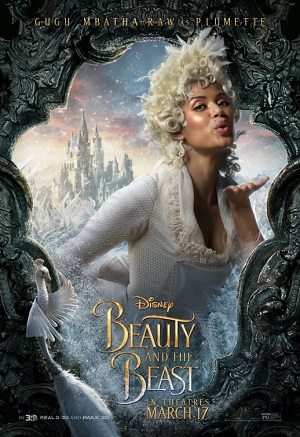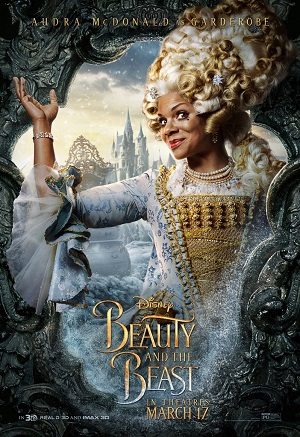In the fall of 2011, I met Emma Watson while studying at Oxford University in England. At the time the live-action Beauty and the Beast movie was only just being considered by Disney, and Watson was rumored to be attached to the project. As I waited for her to sign a page in my notebook, I asked Watson if she was actually attached to the movie. When she said she was, I blurted out, “Good, because I think you’d be perfect!” At the time I meant it with my whole heart. Ultimately, however, I’ve outgrown both Disney, Watson, and their limited views on feminism.
Let me say right now that I desperately wanted to love Beauty and the Beast and Watson in the role of Belle. Belle was “my” Disney princess growing up, the one I identified with the most as a book-lover who was often regarded as “odd” by her local community. I had the soundtrack memorized by seven, yelled at Gaston when I watched the Disney World Beauty and the Beast show as a child, was prepared to wait an hour to eat lunch in the Beast’s castle when I visited Disney World three years ago, and was tickled pink when the actress who played Belle in the original Broadway show recently followed me on Twitter. (And I simply had to participate in WWAC’s analysis of the iconic ballroom scene.)

I was ecstatic when Disney announced that it would be doing a live-action version with Emma Watson as Belle. Watson, of course, played Hermione Granger in the Harry Potter movies, of which I was also a fan of at the time, and indeed, she seemed to me to be the perfect choice to play Belle. “You’re my role model,” I told her when she gave me her autograph. “You show girls that they can be both pretty and smart at the same time and don’t have to choose one or the other” (like me, Watson was studying “abroad” at Oxford, but she also attended Brown University and graduated in 2014). It’s no coincidence that Watson was chosen to be the face of Disney’s adaptation of its Oscar-winning film. Belle and her story is clearly supposed to be feminist.
Unfortunately, neither Watson nor the 2017 film succeeded at those goals. To be fair, we all have internalized misogyny and other issues that we need to work on. (Or, as Zoé Samudzi wrote for Cosmopolitan while critiquing Watson’s feminism, “No one on the planet sashayed out of the womb with a fully formed gender analysis or perfectly curated set of opinions.”) Watson, however, is a UN Women Goodwill ambassador and the face of the UN’s “He for She” campaign. She presents herself as a feminist icon and is appropriately held up to a higher standard than most. Sadly, she hasn’t seemed to have developed past her own white feminism.
When asked by one fan on Twitter if she was a “white feminist,” Watson responded defensively (see below), pointing out that the position had been bestowed upon her by two black women and had mentioned her privilege approximately five times during her UN speech. Sorry, Watson, but having black women as your bosses and merely mentioning your privilege does not make you an intersectional feminist. Whatever happened to using your platform to support other, marginalized women’s voices? Watson’s statements reveal a basic lack of understanding concerning intersectional feminism.
It makes sense, for example, for Watson to be chosen as the face of the “He for She” campaign since she is so well-known. It can be argued, however, that Watson’s whiteness was a key factor in her being selected to play Hermione, the role that catapulted her to international prominence and success. In other words, Watson’s white privilege enabled her to more easily take on other privileged statuses such as financial wealth and provided her with opportunities that are not available to actors of color. Even if Watson fully understood the relationship between her skin color and her success, her claim to support marginalized women’s voices mean little without any deeds to support her rhetoric. Actions, of course, always speak louder than words.
.@emeraldsgreen I want as many people as possible to feel seen, heard and included in this movement. pic.twitter.com/QHogOflPYn
— Emma Watson (@EmmaWatson) October 9, 2015
Watson, therefore, approached the role of Belle with a skewed idea of intersectional feminism. She has, for instance, explained that she believes Belle to be a better role model than Cinderella, because Cinderella is passive while Belle is not. Putting aside a much-needed discussion on domestic abuse in fairy tales, comparing one female character to another and upholding one as more “feminist” than the other is inherently problematic. There are many ways to be feminist. Being outspoken is only one such way. The “I’m the only girl in my town who likes to read, I’m so special” outsider trope that Belle personifies is also underlined by a similar exceptionalism, an understanding that the protagonist is superior to all the other women in her community, hardly feminist or inclusive.
If Watson is to be believed, she is also the source of many changes surrounding Belle’s character and appearance all in the name of feminism. These included tweaking Belle’s costume so that she wore more boots instead of flats and adding pockets to her dresses for practicality. While the effort to make Belle’s outfits more realistic is appreciated, it’s hardly groundbreaking. Watson was apparently involved in the decision to make Belle an inventor herself instead of just assisting her father. As seen with Watson’s lauding of Belle for being feminist because she’s “in charge of her own destiny,” Watson has a clear but exclusionary view on what make a feminist.
After selecting Watson to play Belle, it’s no surprise that Disney also misses the point of intersectional feminism. Over-hyping a (supposedly) explicitly gay character, for example, or merely including black women among the supporting and general cast isn’t exactly a radical decision in 2017 (the cast of Hamilton says hello). After all, Belle, the main character of the film, whose name literally translates to “beautiful,” still fulfills society’s mainstream view of female beauty: white, thin, and enabled (just to start!) Disney may market itself as progressive, but it really isn’t even among Beauty and the Beast adaptations. The unaffiliated Beauty and the Beast television show on the CW, for example, features Kristin Kreuk as Catherine Chandler/Beauty. Kreuk is a Canadian actress with Chinese and Dutch heritage.

Clearly, the most revolutionary feminist decision that Disney could have made would be to choose a Belle of color. With her limited acting skills and mediocre singing, Watson was not the best or most qualified actress for the role. She was chosen because she draws audiences. (Watson’s whiteness, as discussed earlier, is a strong factor in her success and celebrity.) By falling back on whiteness as default, Disney missed the chance to bring more nuance to the character. Having a woman of color as Belle would solidify and reinforce a visual reminder of Belle’s “outsider” status, but not in a way that undermines other women in the village. A Belle of color would also have sent the message that women of color are beautiful as well. Even if Disney had gone forward with Watson or another white actress, there were other ways that the female characters of color could have been more developed either through more lines beyond simply humorous ones or by including “Human Again,” the song cut from the original Beauty and the Beast film, but included in subsequent releases and in the Broadway musical. It also doesn’t speak well to Watson’s and Stevens’ acting and chemistry that I was more invested in the interracial staff romances rather than Belle and the Beast’s.
Don’t get me wrong, I enjoyed watching Beauty and the Beast. It was beautiful, the music was lovely (even if most of the singing was sub-par), and I cried at all the right parts, but I left the theater feeling dissatisfied. Disney tried to create a feminist Beauty and the Beast, but by choosing Watson and her limited white feminism views, it actually revealed how far the company still has to go to be considered progressive.

